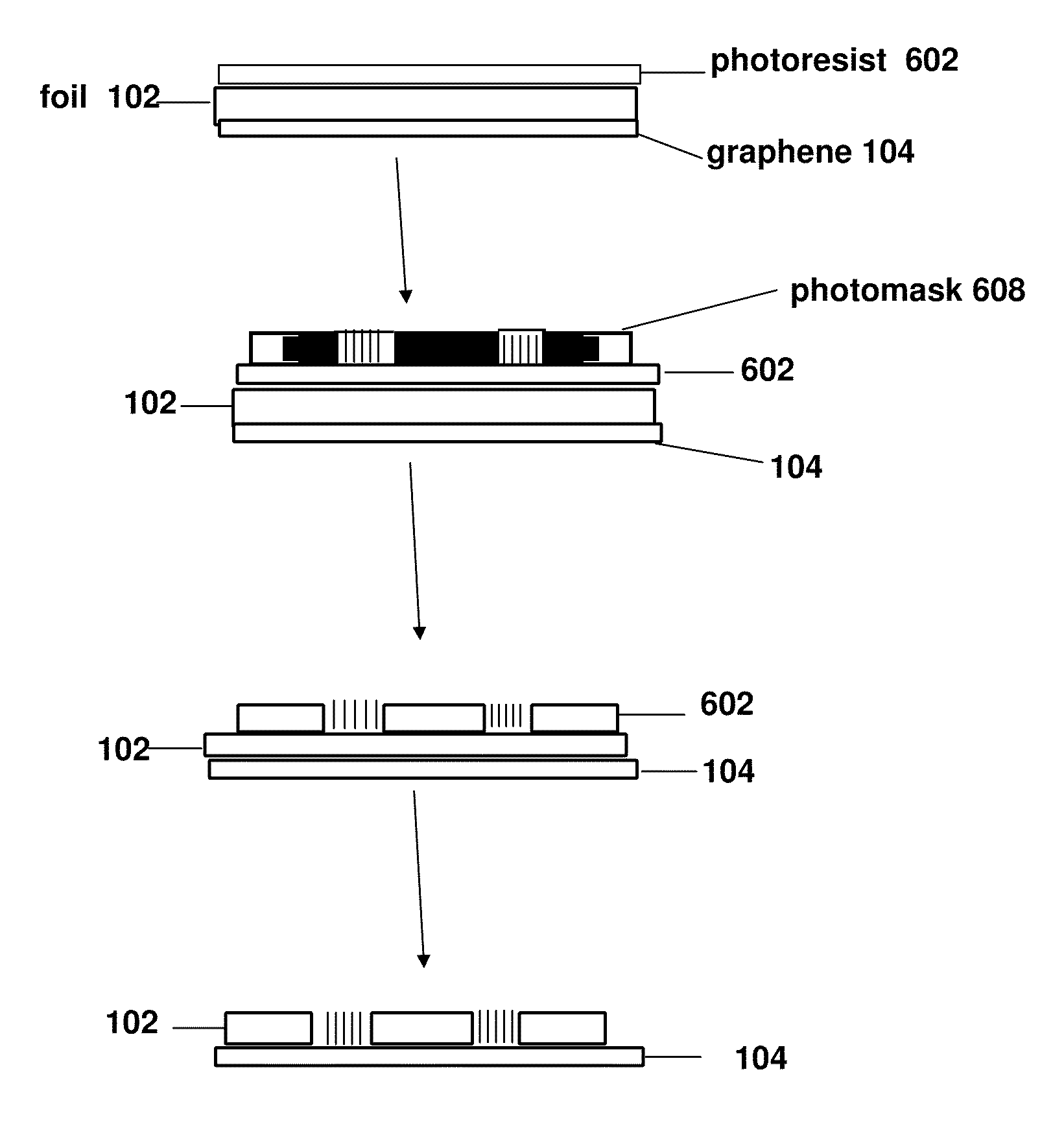Suspended Thin Film Structures
a thin film, suction technology, applied in the direction of layered products, transportation and packaging, chemistry apparatus and processes, etc., can solve the problems of large but dirty and often cracked graphene sheets, requiring either delicate or cumbersome processing, and requiring a large amount of processing. to achieve the effect of strengthening the bond
- Summary
- Abstract
- Description
- Claims
- Application Information
AI Technical Summary
Benefits of technology
Problems solved by technology
Method used
Image
Examples
example 1
Preparation of a Graphene—Holey Carbon Grid Useful as a TEM Support
Preparation of a Graphene ATF on a Copper Foil Substrate
[0074]The direct transfer process begins with layer-area graphene growth on a Cu foil (Alfa Aesar #13382, 25 microns thick) via low-pressure chemical vapor deposition (See FIGS. 1 and 2).
Assembling the ATF-Substrate on a Carbon Grid Support so that the Graphene and Carbon are in Contact A hole-bearing carbon support over a target TEM grid (SPI Au Quantifoil with 1.2 um holey amorphous-C, (“a-C) film) is placed on top of the graphene on Cu, such that the a-C film faces down towards the graphene. Other forms of mesh on foil TEM supports may be obtained or used. These are sold e.g., by Ted Pella, Inc. Redding, Calif. See, FIG. 1A.
Adhering the ATF Graphene to the Carbon Grid
[0075]A drop of isopropanol (IPA) is gently placed on top of the grid, wetting both the grid's a-C film and the underlying graphene film. As the IPA evaporates, surface tension draws the graphene...
example 2
Characterization of Graphene TEM Grids
[0078]Characterization of direct transfer graphene TEM grids is performed on a JEOL 2010 TEM operated at 100 kV. FIG. 3 shows the graphene grid prepared in Example 1 at different magnifications. Macroscopic grid-wide graphene coverage is apparent in FIG. 3A, an optical micrograph captured near the end of the evaporative adhesion step. Darker regions in this image show where graphene has bonded to the a-C support. FIG. 3B, a subset of a grid frame captured by TEM, reveals large unperturbed graphene sheets with occasional folds and cracks. FIG. 3C shows a higher magnification image of a single graphene domain covering an a-C hole. FIG. 4A shows a typical view of the suspended graphene, with large (tens of nanometers) atomically clean regions separated by scattered amorphous and / or organic materials covering the highly reactive graphene surface, rivaling the cleanliness seen earlier with exfoliated graphene flakes transferred to TEM grids and descr...
example 3
Photolithographic Patterning to Selectively Etch Cu Growth Substrates: an Alternate Route to Suspended Graphene Architectures
[0082]As shown in FIG. 6A, foil 102 is layered with graphene 104 as previously described. A layer of photoresist 602 (FIG. 6B) is applied to the copper foil layer. FIG. 6C shows a photomask containing the structure of the entire TEM grid (scaffolding, outer support ring, etc.) being placed over the substrate. As is known in the art of photolithography, UV light is shined on the structure through the mask 608. (The photomasks can be designed to have arbitrary geometric layout; for instance, a mask containing an indexed pattern array—a reference grid—can be made to facilitate the characterization of the same region of the grid for experiments involving a series of processing or modifications to a sample). The exposed photoresist is then removed (FIG. 6D) when the substrate is soaked in photoresist developer; after copper etching, the remaining photoresist is rem...
PUM
| Property | Measurement | Unit |
|---|---|---|
| sieve opening size | aaaaa | aaaaa |
| sieve opening size | aaaaa | aaaaa |
| sizes | aaaaa | aaaaa |
Abstract
Description
Claims
Application Information
 Login to View More
Login to View More - R&D
- Intellectual Property
- Life Sciences
- Materials
- Tech Scout
- Unparalleled Data Quality
- Higher Quality Content
- 60% Fewer Hallucinations
Browse by: Latest US Patents, China's latest patents, Technical Efficacy Thesaurus, Application Domain, Technology Topic, Popular Technical Reports.
© 2025 PatSnap. All rights reserved.Legal|Privacy policy|Modern Slavery Act Transparency Statement|Sitemap|About US| Contact US: help@patsnap.com



